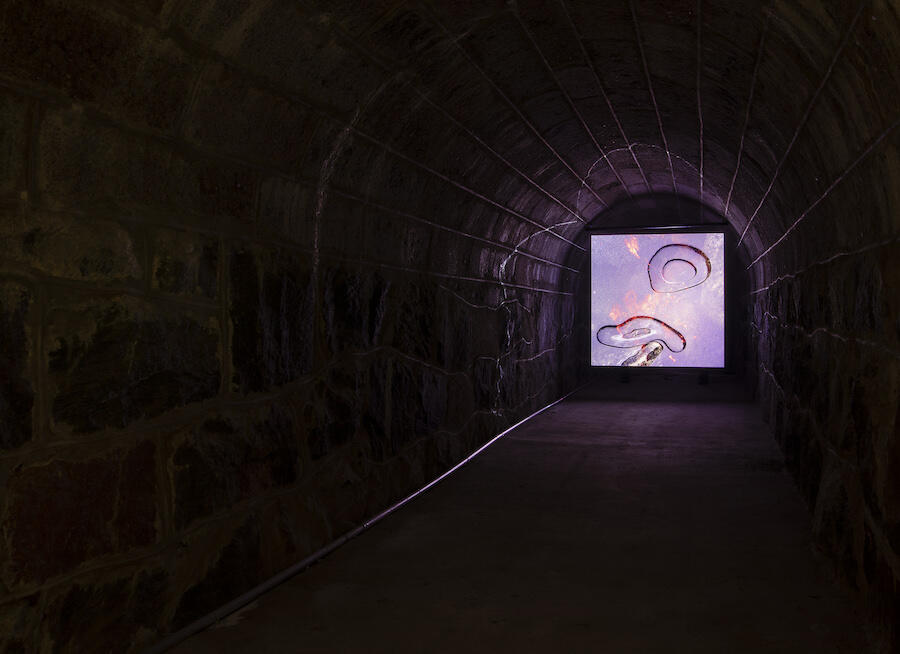At the Helsinki Biennial, Environmental Concerns Loom Large
This year’s edition reflects the country’s ambitious climate targets but risks obscuring what it aims to highlight
This year’s edition reflects the country’s ambitious climate targets but risks obscuring what it aims to highlight

A mere 20 minutes by ferry from Helsinki, the uninhabited island of Vallisaari feels far removed from Finland’s capital city, the sights and sounds of which are obscured by dense forests. Among the ponds, rocky shores and greenery, traces of the island’s previous life as a military base remain, albeit now fused with the landscape. Thick moss covers the walls and roofs of former ammunition stores and barracks, while fragments of long-discarded machinery border the island’s dirt paths.

The main venue of the recently opened Helsinki Biennial, Vallisaari is a fitting location for an event that explores topics such as contamination, regeneration and agency. Bringing together 29 international artists and collectives under the title ‘New Directions May Emerge’, the exhibition displays clear focus on how these topics manifest in the natural world – from Alma Heikkilä’s installation coadapted with (all works 2023), a sculpture coloured with dye infused with local plants, to Ahmed Al-Nawas & Minna Henriksson’s Green Gold, which uses augmented reality to track a logging raft moving between Vallisaari and a neighbouring island.

The environment has been a popular theme of art events in the Nordic region of late, with both the Henie Onstad Triennial and the upcoming Turku Biennial including works that centre on endangered or extinct species as well as resource and energy distribution, amongst other climate-change related topics. This interest mirrors the concerns that loom large in the region’s politics: the Finnish government has ambitious plans to become carbon neutral by 2035 and carbon negative by 2040; Denmark aims to stop using fossil fuels by 2050; and roughly three-quarters of Greenland’s power already comes from renewable supplies.

Yet, as the Helsinki Biennial highlights, these efforts have also caused conflict with the region’s indigenous Sámi population. In Norway, indigenous groups are involved in an ongoing legal dispute with the government about two windmill farms in Trøndelag county, ruled unlawful in 2021 for disrupting traditional reindeer herding routes, but still operating. This is the subject of several works in the show, such as research agency INTERPRT’s Colonial Present: Counter-mapping the Truth and Reconciliation Commissions in Sápmi. Shown at the Helsinki Art Museum and the Oodi Library, it brings together materials – some of which were used to support the Sámi’s legal case – including a map and a timeline of land dispossession and archival images of Sámi residential schools.

Similarly, on Vallisaari, Matti Aikio draws on his Sámi background and his experience of herding reindeer to address indigenous issues in the film Oikos. Set to ambient sound and traditional joiking, the film features double-exposed footage of the Lapland landscape, with reindeer blurring into each other to dreamy effect. The work feels almost timeless, save for a figure on a modern snowmobile and clips of windmills referencing the ongoing legal case.

A less contentious environmental topic also in focus is the effort to clean up the Baltic Sea, currently one of the most polluted in the world. Emilija Škarnulytė takes this marine contamination as the nexus for her installation and video work Hypoxia. It features documentary footage of the Baltic during the 2022 Nord Stream gas leak interspersed with shots of the sea floor, which is lined with discarded ammunition that now leeches chemicals into the water. These scenes are juxtaposed with digital images inspired by the Lithuanian myth of Jūratė, a mermaid whose tears for her murdered beloved manifest as the amber that washes up on the shores of the Baltic. The work mourns the sea’s present while drawing on the boundlessness and hopefulness of a fictional story to inform its future.

While many of these artworks suit their idyllic setting – a notable example being the beguiling Sanctuary Mist by the collective Remedies, which effects a perpetual haze over the surface of one of the island’s man-made freshwater ponds – the decision to install most works in an environmentally protected site that is divorced from the daily lives of local people also has its drawbacks. Although providing a peaceful location in which to reflect upon what needs preserving, Vallisaari’s lushness is deceptively reassuring about the harsh realities of environmental damage while its distance from the mainland and lack of inhabitants reinforces the notion that nature and humanity are separate entities.

A rare exception is Zheng Mahler’s Soilspace. Hung on a wall bordering a thoroughfare in Helsinki designed for cyclists and pedestrians, the billboard-size vinyl mesh depicts vibrant, computer-generated images of subterranean microorganisms and folkloric, earth-dwelling creatures. By placing more works in public settings such as this, ‘New Directions May Emerge’ could have capitalized on the opportunity to encourage a broad spectrum of local people to consider – and potentially take action on – the issues it seeks to address.
‘New Directions May Emerge’ is on view at various venues, Helsinki, until 17 September.
Main image: Keiken, Ángel Yōkai Atā, 2023, installation view. Courtesy: the artists; photograph: © HAM/Helsinki Biennial/Kirsi Halkola
























